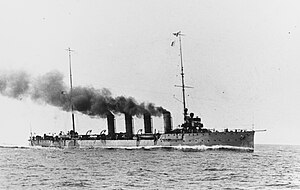 Saida underway in 1914
| |
| History | |
|---|---|
| Name | SMS Saida |
| Namesake | Corvette Saida (1879), commemorating the capture of Sidon (1840) |
| Builder | CNT, Monfalcone |
| Laid down | 9 September 1911 |
| Launched | 26 October 1912 |
| Completed | 1 August 1914 |
| Fate | Ceded to Italy, 19 September 1920 |
| Name | Venezia |
| Namesake | Venice, Italy |
| Acquired | 19 September 1920 |
| Stricken | 11 March 1937 |
| Fate | Scrapped, 1937 |
| General characteristics (as built) | |
| Class and type | Novara-class scout cruiser |
| Displacement | 3,500 long tons (3,600 t) |
| Length | 130.64 m (428 ft 7 in) |
| Beam | 12.79 m (42 ft 0 in) |
| Draft | 4.6 m (15 ft 1 in) |
| Installed power | 25,600 shp (19,100 kW) |
| Propulsion |
|
| Speed | 27 knots (50 km/h; 31 mph) |
| Range | 1,600 nmi (3,000 km; 1,800 mi) at a speed of 24 knots (44 km/h; 28 mph) |
| Complement | 340 |
| Armament |
|
| Armor |
|
SMS Saida was a Novara-class scout cruiser built for the Austro-Hungarian Navy in the early 1910s. The ship was armed with a main battery of nine 10 cm (3.9 in) guns, and six twin 53.3 cm (21.0 in) torpedo tubes were added in 1917. She was built by the Cantiere Navale Triestino shipyard from 1911 to 1914, entering service days after the outbreak of World War I. She spent the war as a flotilla leader, conducting raids and patrols in the narrow waters of the Adriatic Sea.
In May 1917, Saida took part in the Battle of the Strait of Otranto, the largest naval action in the course of the war in the Adriatic. Saida was tasked with provoking a final fleet confrontation in June 1918, but the attack was called off after the dreadnought battleship SMS Szent Istvan was sunk by an Italian motor torpedo boat. Saida was ceded to Italy after the war and commissioned as Venezia. She served in the Regia Marina (Royal Navy) from 1921 to 1937, ending her career as a barracks ship after 1930. The ship was ultimately broken up for scrap in 1937. The three Novara class cruisers were the largest vessels of the former Austro-Hungarian Navy to see service in foreign navies after the war.